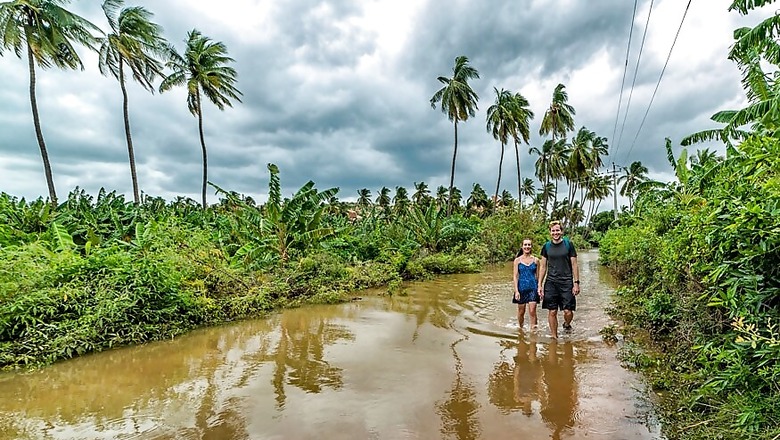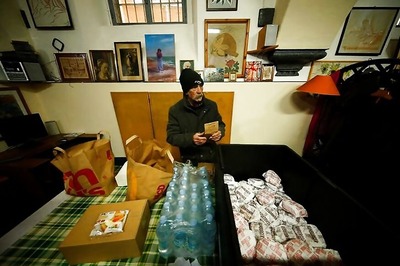
views
New Delhi: Extreme weather events, such as severe rainfall, hailstorms, heatwaves and cyclones, are going to increase in frequency and intensity due to climate change, says KJ Ramesh, former director general of the India Meteorological Department (IMD), while adding that development models need to keep pace.
The IMD has predicted that the withdrawal of the southwest monsoon from western Rajasthan, already delayed by a month, is unlikely to begin until the second week of October. It has forecast excess rainfall over Bihar, eastern Uttar Pradesh, Jharkhand and the plains of Bengal. About 150 people have died in rain-related incidents across the country. Rainfall, meanwhile, continues in large parts of India with the withdrawal of the monsoon delayed.
Ramesh, who was senior adviser to the ministry of earth sciences for atmospheric sciences and climate, explained that this delay is one that scientists have been observing for nearly a decade. “From 2010, one sees that the length of the monsoon has become longer,” he said.
In order for the monsoon to withdraw, an anticyclone – effectively a high- pressure area around which air circulates in a clockwise direction – needs to form, he pointed out. A cyclonic circulation is the opposite, when the air circulates in a counterclockwise direction and lowers atmospheric pressure and temperature, leading to the air cooling down and precipitation.
Ramesh explained that this “clockwise wind pattern needs to emerge for northwest India and when that happens it slowly becomes drier”, pushing the “monsoon air mass towards the east”. But this year, there was “no possibility of an anticyclonic condition forming over northwest India “because time after time low-pressure circulations” had been arising.
While, largely, this increased rainfall could mean good news, especially for north and northwest India, Ramesh pointed out the dangers of extreme weather conditions due to climate change. “Extreme weather events are taking place, whether it is rains, or hailstorm, or heatwaves or cyclones,” he said. “These are four or five seasons; every season there are a couple of extreme weather events. The frequency of these are going to increase due to climate change, and the intensity will increase. Not just in India, but all over the world.” Ramesh explained that with the extension of the monsoon, instances of heavy rainfall – an extreme weather event associated with the monsoon – were being seen over Uttar Pradesh and Bihar, and intermittently over states like Madhya Pradesh and Telangana. “Since the monsoon is extended, it is staying, and in low-pressure areas one can see heavy rainfall events...in that way it is attributed to climate change,” he pointed out.
Asked about variations in the concentration of rainfall, often in the same city, Ramesh said, “Whenever rainfall comes, there is a particular intensity. Rainfall takes place, but the intensity is not the same. Rainfall intensity varies within the zone or precipitation. So, some parts of the city receive more rainfall.” He cited the example of the deluge in Mumbai in 2005, when during the 24-hour period of July 26-27, Santacruz received record-high rainfall of 94.4 cm – while Colaba, just 24 km away, received accumulated rainfall of only 7.3 cm.
“That difference can persist, but for each zone, for instance...take Colaba and Santacruz. In such cases, the drainage can only take away the water collected for each. There is a quantum of rainfall. We can calculate the volume (of rainfall) and drainage systems are accordingly designed to draw the water,” he said, adding that drains are often not functioning at full capacity due to lack of cleaning or de-silting. “Those things have to be factored in.”
As cities grow, he argued, the drainage capacity also needs to improve – something that isn't happening. “You have to create storm-water drainage capacity...when you don’t have drainage, you have to minimise. The option for minimising are local tanks around the city, like jheels (lakes) or ponds,” he said, pitching for clearing out palaeochannels (remnants of inactive rivers or stream channels that have been filled or buried).
These palaeochannels, he explained, existed in all cities, and cited the example of the now-extinct streams that once fed the Hauz Khas lake in Delhi. “They have to be cleared of obstruction...they are not getting water now. The inflow channels of these tanks are blocked. You can always retrace those channels. How earlier they’d get connected...that effort has to happen,” he said.
“Now the water isn't reaching the lake. You can open up those channels. If a construction is there, you can create a subsurface drain, by putting big pipes below the construction,” he pointed out, adding that this would also increase groundwater recharge. “Otherwise you’ll see how it is happening, year after year in Mumbai,” he said, underscoring that efforts were being made to stop urban flooding, but to little avail.



















Comments
0 comment